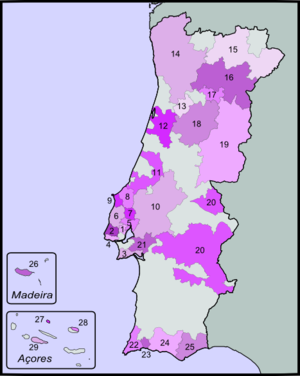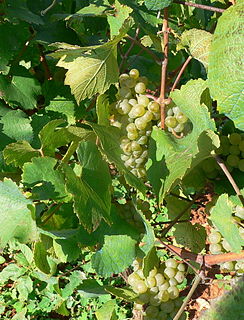
Malvasia is a group of wine grape varieties grown historically in the Mediterranean region, Balearic Islands, Canary Islands and the island of Madeira, but now grown in many of the winemaking regions of the world. In the past, the names Malvasia, Malvazia, and Malmsey have been used interchangeably for Malvasia-based wines; however, in modern oenology, "Malmsey" is now used almost exclusively for a sweet variety of Madeira wine made from the Malvasia grape. Grape varieties in this family include Malvasia bianca, Malvasia di Schierano, Malvasia negra, Malvasia nera, Malvasia nera di Brindisi, Malvasia di Candia aromatica, Malvasia odorosissima, and a number of other varieties.

Vinho Verde refers to Portuguese wine that originated in the historic Minho province in the far north of the country. The modern-day 'Vinho Verde' region, originally designated in 1908, includes the old Minho province plus adjacent areas to the south. In 1976, the old province was dissolved.

Galician wine is Spanish wine made in the autonomous community of Galicia in the northwest corner of Spain. It includes wine made in the provinces of A Coruña, Ourense, Pontevedra and Lugo. Within Galicia are five Denominacións de Orixe (DO): Monterrei, Rías Baixas, Ribeira Sacra, Ribeiro and Valdeorras. In recent years, the region has seen a resurgence in its wine industry led by the international acclaim being received by the Rías Baixas region for its Albariño wines.
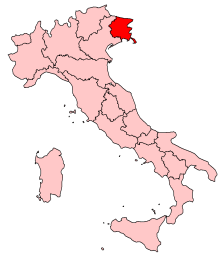
Friuli-Venezia Giulia wine is wine made in the northeastern Italian region of Friuli-Venezia Giulia. Once part of the Venetian Republic and with sections under the influence of the Austro-Hungarian Empire for some time, the wines of the region have noticeable Slavic and Germanic influences. There are 11 Denominazione di origine controllata (DOC) and 3 Denominazione di Origine Controllata e Garantita (DOCG) in the Friuli-Venezia Giulia area. The region has 3 Indicazione Geografica Tipica (IGT) designations Alto Livenza, delle Venezie and Venezia Giulia. Nearly 62% of the wine produced in the region falls under a DOC designation. The area is known predominantly for its white wines which are considered some of the best examples of Italian wine in that style. Along with the Veneto and Trentino-Alto Adige/Südtirol, the Friuli-Venezia Giulia forms the Tre Venezie wine region which ranks with Tuscany and Piedmont as Italy's world class wine regions.

Chaves is a Portuguese wine region centered on the town of Chaves in the Trás-os-Montes e Alto Douro region. The region was initially a separate Indicação de Proveniencia Regulamentada (IPR) region, but in 2006, it became one of three subregions of the Trás-os-Montes DOC, which has the higher Denominação de Origem Controlada (DOC) status. Its name may still be indicated together with that of Trás-os-Montes, as Trás-os-Montes-Chaves.
Planalto Mirandes is a Portuguese wine region centered on the town of Miranda do Douro in the Trás-os-Montes e Alto Douro region. The region was initially a separate Indicação de Proveniencia Regulamentada (IPR) region, but in 2006, it became one of three subregions of the Trás-os-Montes DOC, which has the higher Denominação de Origem Controlada (DOC) status. Its name may still be indicated together with that of Trás-os-Montes, as Trás-os-Montes-Planalto Mirandês.

Carcavelos is a Portuguese wine region centered on the Carcavelos municipality in Estremadura region and includes land near the cities of Cascais and Oeiras. The region has Portugal's highest wine classification as a Denominação de Origem Controlada (DOC). Located at the very southern tip of the Estremadura region, the region has a long winemaking history dating back to the 18th century when Sebastião José de Carvalho e Melo, Marquis of Pombal owned vineyards here. The region is known for its fortified wine production, creating off dry, topaz colored wines that have nutty aromas and flavors. While once a thriving wine region, world-renowned in the 19th century for its tawny colored fortified wine, in the modern era Carcavelos has been devastated by real estate development in the suburbs of the capital city of Lisbon and nearby coastal city of Estoril.

Tejo, until 2009 named Ribatejo, is a Portuguese wine region covering the same areas as the Ribatejo Province. It takes its name from the river Tejo (Tagus). The entire region is entitled to use the Vinho Regional designation Tejo VR, while some areas are also classified at the higher Denominação de Origem Controlada (DOC) level under the designation DoTejo DOC. VR is similar to the French vin de pays and DOC to the French AOC.

Minho, formerly Rios do Minho, is a Portuguese wine region covering the same areas as the Vinho Verde DOC. The region is classified as a Vinho Regional (VR), a designation similar to a French vin de pays region. The wines of the Minho and Vinho Verde are nearly identical except for the Minho VR allowing foreign grape varieties to be used that are excluded from the Denominação de Origem Controlada (DOC) regulations for Vinho Verde.
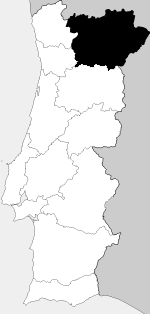
Trás-os-Montes is a Portuguese wine region located in the Trás-os-Montes e Alto Douro region. The entire wine region is entitled to use the Vinho Regional designation Transmontano VR, while some areas are also classified at the higher Denominação de Origem Controlada (DOC) level under the designation Trás-os-Montes DOC. VR is similar to the French vin de pays and DOC to the French AOC.
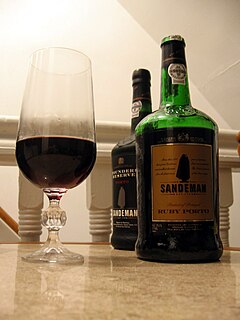
The history of Portuguese wine has been influenced by Portugal's relative isolationism in the world's wine market, with the one notable exception of its relationship with the British. Wine has been made in Portugal since at least 2000 BC when the Tartessians planted vines in the Sado and Tagus valleys. By the 10th century BC, the Phoenicians had arrived and introduced new grape varieties and winemaking techniques to the area. Up until this point, viticulture was mostly centered on the southern coastal areas of Portugal. In later centuries, the Ancient Greeks, Celts and Romans would do much to spread viticulture and winemaking further north.

The Douro Wine Company was a government oversight organization established by the Portuguese Prime Minister Sebastião José de Carvalho e Melo, Marquis of Pombal to regulate the trade and production of Port wine. Established in 1756, one of the first official duties of the company was the delineation of the boundaries of the Douro wine region. This act essentially made the Douro the world's first regional appellation. While the boundaries of the Chianti and Tokaji wine regions were outlined in 1716 and 1737, respectively, neither of these regions were "technically" appellations in the sense of being subjected to continued government control and regulations. Under their charter, Pombal invested an immense amount of control in the Douro Wine Company to regulate all exports of Port, set production quantities limits, fix maximum and minimum prices for grapes and to serve as sole arbitrator in any disputes between vine growers and Port shippers. In 1761, the company was further granted a monopoly on the sale of brandy which was used in the fortification process of Port winemaking. The Douro Wine Company continued to operate to 1833. Today, many of it functions have been deregulated with the Instituto dos Vinhos do Douro e do Porto or being the official regulating body of Port wine and Douro table wine production.

The Quinta classification of Port vineyards in the Douro is a system that grades the terroir and quality potential of vineyards in the Douro wine region to produce grapes suitable for the production of Port wine. In Portuguese, a quinta is a wine producing estate, which can be a winery or a vineyard. While other wine classification systems may classify the winery, the Douro quinta classification is based upon the physical characteristics of the vineyard. The classification system is run by the Instituto dos Vinhos do Douro e Porto (IVDP) and shares some similarities to the classification of Champagne vineyards in that one of the purposes of the system is to ensuring that vineyards producing grapes with the highest quality potential receive a high price. A secondary function of the quinta classification is the establishment of permitted yields for production. Quintas with a higher classification are permitted to harvest more grapes than a vineyard that received a lower classification.

Vital is a white Portuguese wine grape variety that is grown primarily in Western Portugal. Sometimes known under the synonym Malvasia Corado, the variety tends to produce rather neutral flavor wine with low acidity unless the grape is grown in vineyards of high altitude.
Rufete is a red Spanish/Portuguese wine grape variety that is grown primarily used in port wine production in the Douro region of Portugal. It is also grown up along the Duero basin across the border in the Spanish province of Castile and León and can be found in the Dão DOC of Portugal where the variety is known as Tinta Pinheira.
